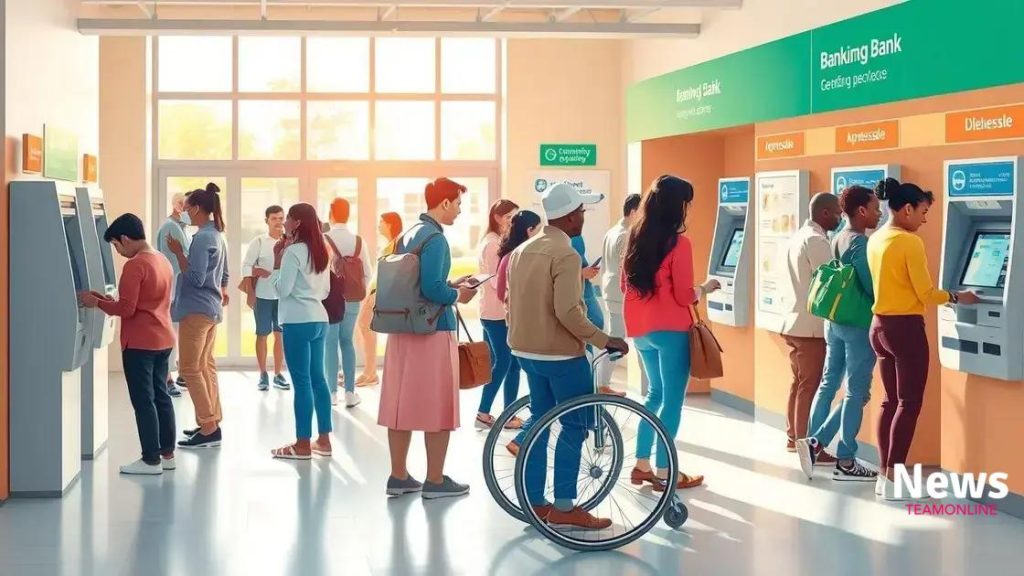Equitable access to banking services: a game changer

Equitable access to banking services ensures all individuals can utilize financial services, supported by technology, community engagement, and targeted initiatives tailored to underserved populations.
When we talk about equitable access to banking services, it’s not just about transactions—it’s about creating opportunities for everyone. Have you ever wondered how access to basic banking affects your community? Let’s dive into this important topic and its implications.
Understanding equitable access to banking
Understanding equitable access to banking is essential for fostering inclusive financial environments. Each individual deserves the opportunity to participate in the banking system, which can significantly impact their economic stability. By ensuring that everyone has the tools and resources they need, communities can thrive.
What is equitable access?
Equitable access means that all individuals, regardless of their background or financial status, have the same opportunity to utilize banking services. This includes opening bank accounts, obtaining loans, and accessing financial education.
Challenges faced
Many face barriers that hinder their ability to access banking services. Here are some common challenges:
- Lack of nearby banks in low-income areas.
- High fees associated with banking services.
- Limited financial literacy among some populations.
- Discrimination based on race or economic status.
Addressing these challenges is crucial for enhancing equitable access to banking. If individuals are unable to access financial services, they struggle to build credit, save money, and invest in their future. Further, the absence of trust in financial institutions can exacerbate these issues.
Importance of technology
Technology plays a pivotal role in improving access. Digital banking solutions can bridge gaps by offering services that traditional banks may not provide in certain areas. Mobile banking and online services make it easier for those in remote locations to engage with financial resources.
Moreover, educational initiatives using technology can empower individuals to navigate the banking system more effectively. Interactive online platforms can provide tutorials and resources that promote financial literacy.
Barriers to banking access for underserved communities
Barriers to banking access for underserved communities can create a cycle of financial exclusion. These obstacles prevent many individuals from benefiting from essential banking services. Understanding these barriers is the first step toward addressing them effectively.
Common barriers faced
Various factors contribute to limited access for certain communities. Here are some of the most common barriers:
- Geographical isolation: Many underserved areas lack nearby bank branches, making it hard for residents to access services.
- High fees: Some banks impose steep fees that disproportionately affect low-income individuals.
- Lack of identification: Many banks require government-issued ID to open an account, posing a challenge for those without such documentation.
- Limited financial literacy: A lack of understanding about banking processes can discourage people from seeking access.
These barriers often lead to individuals relying on alternative financial services, like check cashing or payday loans, which can be more costly and risky.
The impact of discrimination
For various marginalized groups, discrimination also plays a significant role in restricting access. Whether it’s based on race, gender, or economic status, this discrimination can deter people from seeking help from financial institutions. Many individuals feel unwelcome in banks or don’t trust these institutions due to past experiences.
Furthermore, when communities perceive the banking system as untrustworthy, they are less likely to engage with it, leading to a continued cycle of exclusion. Education and outreach can help bridge this trust gap, providing needed transparency and support.
Solutions to overcome barriers
Addressing barriers requires a multifaceted approach. One effective strategy is partnering with community organizations to identify needs and provide tailored solutions. Financial education workshops can empower individuals, boosting their confidence in navigating the banking system.
Additionally, creating policies that promote inclusive practices within financial institutions can help dismantle the barriers faced by underserved communities.
The role of technology in improving access

The role of technology in improving access to banking services is transformative. Innovative solutions are reshaping how individuals interact with banks, especially in underserved communities. By leveraging technology, we can dismantle barriers and enhance financial inclusivity for everyone.
Digital banking platforms
Digital banking offers an array of services that simplify financial interactions. Clients can easily manage accounts, transfer funds, and access loans from their smartphones or computers. This convenience makes banking accessible to those without physical bank branches nearby. Additionally, digital platforms often have lower fees, making banking more affordable.
Mobile applications
Mobile banking applications provide users with the tools they need at their fingertips. These apps can include features like:
- Instant account balance checks.
- Online bill payment options.
- Financial budgeting tools.
- Real-time transaction alerts.
Through such applications, people can gain greater control over their finances, making informed decisions without needing to visit a bank in person.
Online financial education
Technology also plays a significant role in enhancing financial literacy. Online educational resources, such as video tutorials and interactive platforms, help users understand banking processes better. By breaking down complex topics like savings and loans into easy-to-understand content, technology empowers individuals to make smarter financial choices.
Moreover, outreach programs can use social media to spread awareness about the importance of equitable access. Informative posts and live workshops can attract attention and encourage engagement from people who may feel excluded from traditional banking systems.
Blockchain and secure transactions
Blockchain technology is another innovative solution that can enhance trust and security in banking. By providing a transparent record of transactions, it helps prevent fraud and builds confidence. Therefore, people are more likely to trust banks that utilize this technology, leading to increased participation in the financial system.
In conclusion, embracing technology is vital for promoting equitable access to banking services. It not only provides convenience but also fosters education and trust among users, ultimately creating a more inclusive financial environment.
Success stories of equitable banking initiatives
Success stories of equitable banking initiatives showcase the positive impact that well-designed programs can have on communities. These initiatives highlight how targeted efforts can enhance financial access and empower individuals from underserved areas.
Community-based banks
One effective strategy has been the establishment of community-based banks. These banks often focus on serving low-income neighborhoods, providing services that traditional banks might overlook. By creating local branches, they become accessible and familiar to the people they serve. These banks typically have lower fees and offer personalized services, which helps build trust within the community.
Microfinance programs
Microfinance is another example of an initiative that has proven successful. These programs provide small loans to individuals who might not qualify for traditional bank loans. By offering financial assistance to entrepreneurs, microfinance helps create jobs and stimulate economic growth. Many microfinance institutions offer training and support, empowering individuals to succeed.
- Support for women entrepreneurs through targeted loans.
- Training programs to improve financial literacy and business skills.
- Flexible repayment options that cater to borrowers’ needs.
These elements combine to promote economic empowerment and foster community development.
Digital inclusion programs
Another success story comes from digital inclusion programs that provide technology access to underserved populations. By offering training in digital literacy and access to online banking tools, these initiatives equip people to manage their finances effectively. During the pandemic, these programs became even more critical as digital banking became a necessity.
These success stories demonstrate the importance of innovative approaches in building equitable access. When communities come together to create solutions, the results can transform lives and encourage financial stability.
Collaborations with local organizations
Many successful initiatives involve partnerships with local organizations. Collaborating with nonprofits helps banks reach more people and customize solutions to meet community needs. This collaborative approach can be particularly effective in addressing unique barriers faced by specific demographics.
Through these collective efforts, financial institutions can break down barriers, increase awareness, and improve access to services, ensuring that everyone has the opportunity to participate in the financial system.
Future trends in equitable banking services
Future trends in equitable banking services are set to reshape the financial landscape. As technology evolves and societal awareness increases, banks are focusing more on inclusivity. This shift will address the needs of underserved communities and foster wider access to banking services.
Emphasis on digital solutions
Digital banking will continue to grow, allowing more people to access financial services online. Mobile payment platforms and online banking apps are becoming more user-friendly, which encourages increased adoption. These digital solutions can reduce costs, provide convenient access, and offer tailored services for different community needs.
Greater financial education
Financial literacy programs will gain more attention. Banks and community organizations will collaborate to provide resources aimed at educating individuals about managing finances. These programs are essential for empowering people to make informed banking choices. They might include online workshops and interactive tools that simplify complex financial concepts.
- Workshops on budgeting and saving.
- Tutorials on using banking apps.
- Outreach to underserved populations.
As more individuals understand banking processes, the confidence to engage with financial institutions increases.
Focus on community engagement
Banks will place a greater emphasis on community involvement. Engaging with local organizations will help them tailor services to meet specific community needs. This approach fosters trust and ensures that banking services are more accessible to everyone.
Through active listening to community feedback, banks can develop initiatives that truly address the barriers people face. Partnering with local nonprofits to deliver targeted services and educational resources will further enhance the impact of these efforts.
Increased regulation and accountability
As societal demand for equitable access grows, regulatory bodies may impose stricter guidelines on financial institutions. This could lead to enhanced accountability, ensuring that banks adhere to equitable practices. such regulations may require banks to offer services that suit all demographics, particularly those traditionally underserved.
The direction of these trends indicates that the future of banking will prioritize accessibility, education, and community engagement, paving the way for a more inclusive financial system.
The future of banking is shaping up to be more inclusive and accessible for everyone. As we’ve explored, technology plays a vital role in enhancing equitable access to banking services. From digital solutions that make banking easier to educational programs that build financial literacy, these initiatives are making a difference. Community engagement and partnerships are crucial for understanding the unique needs of different groups. By focusing on these areas, banks can create a more inclusive financial landscape that empowers everyone to participate fully in the economy.
Here’s a summary of the key points:
FAQ – Frequently Asked Questions about Equitable Access to Banking Services
What is meant by equitable access to banking services?
Equitable access refers to ensuring that all individuals have the same opportunity to utilize banking services, regardless of their background or financial status.
How does technology improve banking access for underserved communities?
Technology enhances access by providing digital banking solutions that make it easier for individuals to manage finances from anywhere, reducing reliance on physical bank branches.
What role do community organizations play in improving banking access?
Community organizations collaborate with banks to tailor services to local needs, educate residents about banking, and promote financial inclusion.
What trends should we expect in the future regarding banking services?
Future trends include increased digital solutions, enhanced financial education programs, greater community engagement, and stricter regulations to ensure equitable practices.





